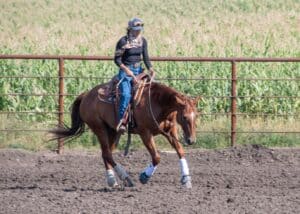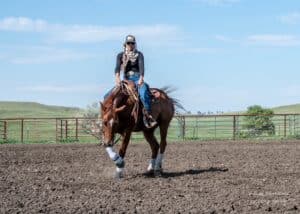ADS

A question I often hear is, “How do I help my horse self-regulate his emotions?”
Learning how to identify and self-regulate our own emotions is one of the most valuable and useful life skills. This is such an important part of our emotional growth, as well as with horses.
Some of us help our horses without even knowing it, but that comes from the way we ride and the confidence we project in our seat. However, many of us have been taught to be quiet, move slow, or don’t poke the bear, so they always look pretty. We micromanage every step, so they don’t fall apart. However, at some point our horses will be forced outside of their comfort zone while we are on their backs. There will be some new factors the horses have never seen before. That’s why it is so important to challenge our horses in a safe environment, so that we can prepare them for the big world and help them to look to us for comfort.
The reason many people struggle with their horse is they have never asked that horse for more. They never challenge them or allow them to work through their emotions. Every step gets micromanaged.
[Photo: Unseen Expressions by Carrie Kovash]
Let’s define challenging them.
Challenging them does not mean flooding them with pressure… that’s not fair, and you will create resentment. First of all, both rider and horse have to be in a calm, alert state, so the horse can learn, think, and respond appropriately. This means that you and your horse are calm enough that you can receive information (rather than over or under react) and alert enough that you are responsive to the information. Recognizing your own emotions and your horse’s emotions is so important, for both safety and success. Your energy will affect the horse’s energy. A horse will first ask, “Am I safe with you?” Our calm presence increases the horse’s feeling of safety. Remember horses can overcome fear with curiosity. Don’t kill their curiosity. Start with relatively low pressure and gradually increase it.
What does challenging look like?
It can be in the form of desensitizing and sensitizing, speeding the horse up, holding that gear for awhile, and then slowing him back down. There are many gimmicks and tricks to play with, but my go-to in all my challenges in teaching my horses to self-regulate their emotions is by getting the feet unstuck and allowing them to find softness and comfort in my hands through their mind and body. We don’t need them “dull” to difficult situations. We need them to not fight, flight, or freeze — meaning soft, relaxed, forward motion.
[Photo: Unseen Expressions by Carrie Kovash]
How do I get them to soften while struggling with something?
- Trust your training, don’t panic!!!
- Simple leg yields are a good way to get your horse’s attention back on you.
- Teach them body control at home that feels like home, so wherever you go, you can fall back on that to change the reacting brain to thinking.
However, if you never challenge your horse, you will find that eventually something will challenge them outside of your control. There’s a reason many ranch horses ride so well wherever they go. They have to pen and sort cows, push fighting bulls, and deal with waving flags and ropes. By the time they go out in the big world to compete, it feels like a day off.
What does self-regulating our emotions look like when it comes to people?
To me, it means to be fully aware of every emotion I am experiencing and to realize that there is no good or bad emotion, but there are good and bad ways to act upon them. The problem is we always tend to dwell on the bad emotion and let it consume us. But what if we can see it for what it is and then let it go?? Easier said that done right?!
Here’s a quick tip from one of my favorite authors, Dr. Caroline Leaf, “See your emotions as house guests, not permanent residents, for example: ‘Anger is visiting’ instead of ‘I’m angry.’ Emotions can show up unannounced, but you get to decide how long they stay.”
Have a blessed day, friends, and remember the motto, “A ship is safe in harbor, but that’s not what ships are built for.”

Elsabe Hausauer is a veteran in the horse training industry. She is the owner of MBR Performance Horses, LLC, clinician, and as she puts it, “forever student of the horse.” Horsewoman, rancher, wife, and mother by way of South Africa, she hangs her hat in Halliday, ND, encouraging the relationship between people and horses through teaching and advocating horsemanship skills to make each ride a better experience.
